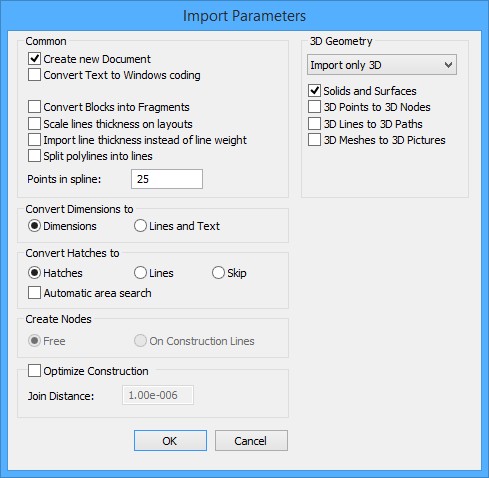When importing AutoCAD documents into T-FLEX CAD, you need to specify the following parameters:
Create new Document. This option directs where the result of the import shall be placed: in the current T-FLEX CAD or in a new document.
Convert Text to Windows coding. Setting this option converts all imported text to Windows encoding. This flag shall be used when importing an AutoCAD document of one of its earlier versions running under DOS.
Convert Blocks into Fragments. This option defines method of processing AutoCAD “block” entities. When the flag is on, blocks will be converted into T‑FLEX CAD fragments. If this flag is cleared, blocks are converted directly into T-FLEX CAD entities.
Converting blocks to T-FLEX CAD fragments may significantly slow down conversion if there are too many blocks and/or they have multilevel hierarchy.
Scale lines thickness on layouts. This parameter scales thickness of lines for drawings views and is helpful after importing from AutoCAD.
Import line thickness instead of line weight. The parameter defines the method of assigning thickness for imported lines.
Split polylines into lines. Imported polylines are divided, if possible, in several lines with simple geometry (segments, splines, arcs). On these lines you can create dimensions.
Points in spline. Specifies number of segments for imported splines representations. May be helpful in case of large number of imported splines. In this case reducing the number is recommended.

The next two groups of options (“Convert Dimensions to” and “Convert Hatches to”) define the method of converting AutoCAD elements (dimensions and hatches) into T-FLEX CAD elements. An additional flag for hatches “Automatic area search” enables the automatic hatch tracking (by the coordinates of points specified in AutoCAD at hatch creation - Pick points). Its use is recommended in the cases when hatch import fails in the normal mode (when the flag is cleared).
During the import, the points of the source AutoCAD drawing are converted (wherever possible) to free 2D nodes within T-FLEX CAD. A large number of such introduced nodes might interfere with further manipulations over the imported drawings. This can be avoided by setting the flag:
Optimize Construction. Upon setting this option, the nodes that are closer to each other than the specified Join Distance, will be merged in one node.
If the flag is cleared, then nodes coincidence is not tested. This helps speed up the import process, while could significantly clutter the drawing.
Note that since the drawings in the DXF and DWG formats are not parametric, those remain non-parametric in T-FLEX.
3D Geometry. This parameter is used when the source AutoCAD file contains 3D solid geometry:
Ignore. When selecting this parameter, 3D geometry is ignored at conversion;
Ignore 3D as 2D. In this case, at conversion 3D bodies from the source AutoCAD model are projected onto 2D drawing, 3D geometry is absent in the resulting T-FLEX CAD file;
Import only 3D. 3D geometry of the source file is transformed into 3D geometry of the T‑FLEX CAD.
●Solids and Surfaces – exact solid and surface geometry will be imported.
●3D Lines to 3D Paths –3D AutoCAD lines will be imported as 3D paths.
●3D Points to 3D Nodes - 3D AutoCAD points will be imported as 3D nodes.
●3D Meshes to 3D Pictures – AutoCAD mesh models will be imported as 3D Pictures.
Just like when exporting, the old data exchange mechanism can be used when importing T-FLEX CAD version 8.0 and earlier data. For this, set the “Use Version 8 Algorithm” flag. The flag is available only for 32-bit version of CAD. Once this flag is set, the option “Automatic area search” becomes inaccessible, while the group of options activates that pertains to the old mechanism:
Create nodes: Free, On Construction Lines. This group of options allows selecting the method of creating nodes in an imported drawing: as free nodes or as intersection points of additionally created horizontal and vertical lines.